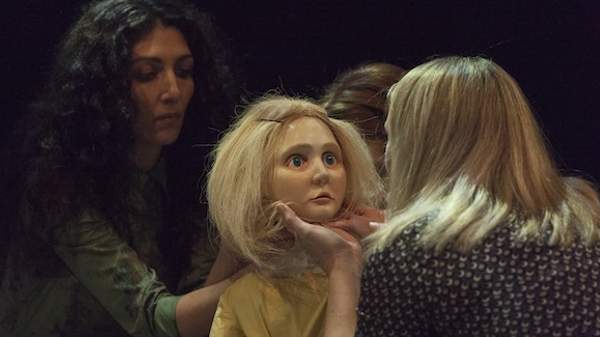Overview
Puppets! Puppets are so rarely seen in this city, and it's a sad oversight. Who doesn't love, loath, or at any rate feel towards a puppet? Puppetry is one of the most ancient of theatrical arts, and aside from the possibilities it affords to take a more lateral tack with staging, we attach a lifetime of connotations to the living dolls — naive, playful, magical, murderous — and those feelings are ready to be tapped at several times, in several ways by a good show.
The Splinter, by acclaimed Australian playwright Hilary Bell, is a good show doing just that. The new work, long in development at the Sydney Theatre Company, began life as a play for children — a fact which seems comically disturbing after you've seen the current version up on stage. Its puppet is a child, Laura, a girl of four returned to her parents, played by Helen Thomson and Erik Thomson, after having been missing for nine months. They don't know what's happened to her in this time, and in many ways, she's a vastly different little individual for it. But while her mother embraces Laura back into her life, for her father, she is too different, and he is tormented by the provenance of this changeling in his house.
The title of The Splinter is inspired by the Hans Christian Andersen fairytale The Snow Queen; it only takes one shard to lodge in your eye for your whole vision of the world to be irrevocably tainted. The play centres on showing the effect this has on the father. As such, it's a very internal drama, and until the moodiness substitutes for tension, the sparse text isn't necessarily exciting. Yet when the show's manipulators of puppet and props start playing their tricks and your own sense of certainty is upended, it becomes an insidious and unnerving psychological thriller.
The Splinter employs a bunraku style of puppetry, which means the puppeteer is not concealed. It's a fun and complex method, perfect for adult theatre, and it works particularly well in The Splinter, where performers Julia Ohannessian and Kate Worsley alternately look like they're playing with the doll, becoming one with the doll, and ditching the doll altogether to transform into representations of the child's personality. The two women also happen to be dressed in identical girlish, dropped-waist dresses, recalling the creepiness of the twins in The Shining.
If anything, there isn't enough time with the puppet before she begins to devolve into more metaphorical fragments. It's also frustrating that her hair mostly falls wildly over her eyes; an audience needs to connect with a puppet through its face just as it would with a human actor. But the overall impression left by The Splinter is of the richly realised worlds that are possible when a deft playwright leaves her isolated writing desk and really works with the stagecraft pros that will bring the story to life on the stage.
Information
When
Friday, August 10, 2012 - Saturday, September 15, 2012
Friday, August 10 - Saturday, September 15, 2012
Where
Wharf 1, Wharf TheatreHickson Road
Sydney
